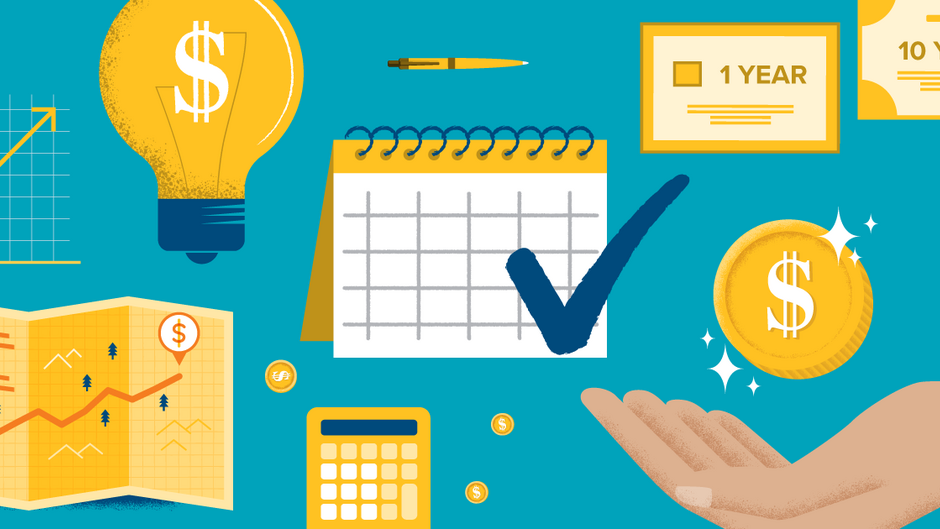Use the RPB Navigator to chart your course.
Enroll and get off on the right foot
You've just joined RPB—or are thinking about it. You might feel that saving for retirement is overwhelming, or you might be ready to jump in with both feet. Either way, it’s never too early to start thinking about retirement—and RPB is here to help guide you through every step.
Things to Consider
Retirement is a long-term investment. If you’re just starting out in your career, then you will likely see your savings fluctuate with the markets over many decades. It’s important to remember that your account is intended as a long-term investment, and should weather these natural ups and downs with time. So stick to your objectives and avoid making emotional or reactive investment decisions.
Now is the best time to start saving. The sooner you contribute to your plan, the longer your savings have time to grow. And the money you save today will grow more than the money you invest tomorrow––making it harder to catch up when you’re closer to retirement. This is due to the power of compounding growth, which occurs when your contributions generate earnings from both the initial principal and accumulated earnings. So contribute as much as you can as soon as you can.
Don’t forget to check in. Being ready for retirement is an ongoing process that starts the day you start saving. While retirement may seem to be a long way off, we recommend that you review your RPB retirement account at least once a year to make sure your retirement assets are allocated according to your goals and to monitor your contributions. As markets move during the year, your original fund allocation may change. Check that you have the auto-rebalancing feature in NetBenefits turned on to ensure that your portfolio is invested according to your desired allocation. Also check to see if you’re on track for the nest egg you need and increase your contributions if you can.
Make a budget. Getting a handle on your expenses is an essential first step to a successful retirement. You may be wondering how to balance debt from student loans and other expenses with saving for retirement. We’ve partnered with Fidelity Retirement Planners so you have access to financial counselors who will help you set up your budget.
Consider your taxes. You have the option to make pre-tax, post-tax Roth contributions, or both to your 403(b) account. Pre-tax contributions mean that your retirement contributions come out of your paycheck before you pay taxes, while Roth contributions mean that you pay taxes now but you withdraw the money and earnings tax free in retirement. Consult with your tax advisor to learn which type of contribution (or combination of both) is right for you.
Make sure you’re protected. Take advantage of RPB’s affordable and comprehensive long term disability (LTD) insurance by enrolling now so that your essential costs are covered if you find yourself unable to work. And don’t forget about RPB’s life insurance offerings, which can help take care of your loved ones after you’re gone.
Save now, thrive later
You're no longer a novice when it comes to saving for retirement. You’re contributing to your RPB plan consistently, and you look forward to seeing those funds continue to grow in the coming years. Just make sure you don’t get complacent. Now’s the time to keep a watchful eye on your accounts to ensure that you won’t fall short of your financial goals for retirement.
Things to Consider
Outline your vision for retirement. Your retirement—and how you choose to live it—is unique to you. Determining your post-retirement goals now is the first step in ensuring that you can achieve them.
Calculate how much money you’ll need in retirement. While it’s dependent on various factors, withdrawing roughly 4% of your total savings every year post-retirement is typically a good starting point to estimate how much you’ll need to maintain a steady, flow of income through retirement. If you’re worried about coming up short, consider increasing your contributions now by even a small amount.
Stay on track, even when other commitments arise. Consider the large purchases you plan to make or other financial commitments you may have before or after you retire, such as buying a home or sending children to college, and be sure to include these when you calculate your savings plan. If you do need extra cash, consider taking a loan from your retirement account. You’ll be paying the money plus the interest back to yourself instead of the bank.
Make sure you’re protected. Take advantage of RPB’s affordable and comprehensive long term disability (LTD) insurance by enrolling now so that your essential costs are covered if you find yourself unable to work. And don’t forget about RPB’s life insurance offerings, which can help take care of your loved ones after you’re gone.
Consider adding a financial advisor to your team. Did you know that many of our participants seek additional professional help when planning for retirement? If you have an advisor, introduce him or her to RPB so that, together, we can develop the best plan for your future. Otherwise, take advantage of our partnership with Fidelity's Retirement Planners for complimentary financial planning.
Ready your resources
Whether you're a decade away from retirement, or it’s within the next year, you’re probably full of questions about how to adequately prepare. We’re here to answer them.
Things to Consider
Attend RPB’s annual Retirement Seminar. Every year, we bring together industry and retirement experts for in-depth sessions. This comprehensive seminar is designed to help you ensure that you’re on track for the retirement you want. Check out the details of our upcoming seminar.
Take advantage of catch-ups. After age 50, you can make catch-up contributions to your 403(b) account in excess of annual IRS limits. It's a simple way to boost your savings as your investments mature.
Start thinking about what type(s) of distribution may be right for you. Consider whether a monthly paycheck, a lump sum payment, an annuity, or some combination will make the most financial sense for your goals and anticipated lifestyle in retirement.
Understand your plan benefits as clergy. Because our retirement plan is a church plan, clergy are entitled to a unique tax benefit—the housing (parsonage) allowance exclusion, when they retire. Learn how the parsonage exclusion works.
Plan your estate. It’s never too early to start thinking about the legacy you’ll leave for your loved ones. Meet with a financial advisor to discuss how to best prepare your assets.
Review your Social Security benefits and check your Medicare eligibility. Make sure sign up for Medicare before you turn 65. Learn more about your options.
Reap the rewards of all of your planning
Congratulations on reaching retirement! As a Reform Movement professional or clergy, you’ve dedicated your life to our shared values, and will continue to do so through your RPB investments. You’ve managed your money well, but you may sense there's more to do—and you’re right.
Things to Consider
Fill your calendar. Whether it's contributing to a community organization or traveling to new places, finding meaningful activities that you may not have had time for during your career will ensure that your retirement is a long and happy one.
Declare parsonage. As clergy, you have the opportunity to exclude your housing expenses from your gross distribution income to reduce your federal income taxes. Consult your tax advisor to determine which of your housing expenses are eligible for the parsonage tax exclusion benefit. We’re also here to help you take advantage of this valuable benefit.
Take advantage of Social Security or Medicare benefits that may now be available to you. These long-standing government programs can supply additional retirement income and healthcare support to those who qualify.
Prepare and share
Whether it's you or your loved one who has retired with RPB, you may be wondering what becomes of the funds after you pass on. Don't worry—RPB will guide participants and their beneficiaries alike toward a smooth transfer of assets.
Things to Consider
When a spouse is the beneficiary of an RPB plan participant, they have several options for receiving the participant's account: they can keep their assets with RPB in a 403(b) account in their name, transfer the assets to an IRA, or take a lump sum distribution. Whatever they decide to do, we’ll help them through the process. Talk to a financial advisor about which option best suits your situation.
When someone other than your spouse is the beneficiary of a RPB plan participant, they will become RPB participants when they receive your inherited account, although they cannot interact with the account in the same way you did. Non-spouse beneficiaries can't contribute to the plan unless they meet RPB’s eligibility requirements.






